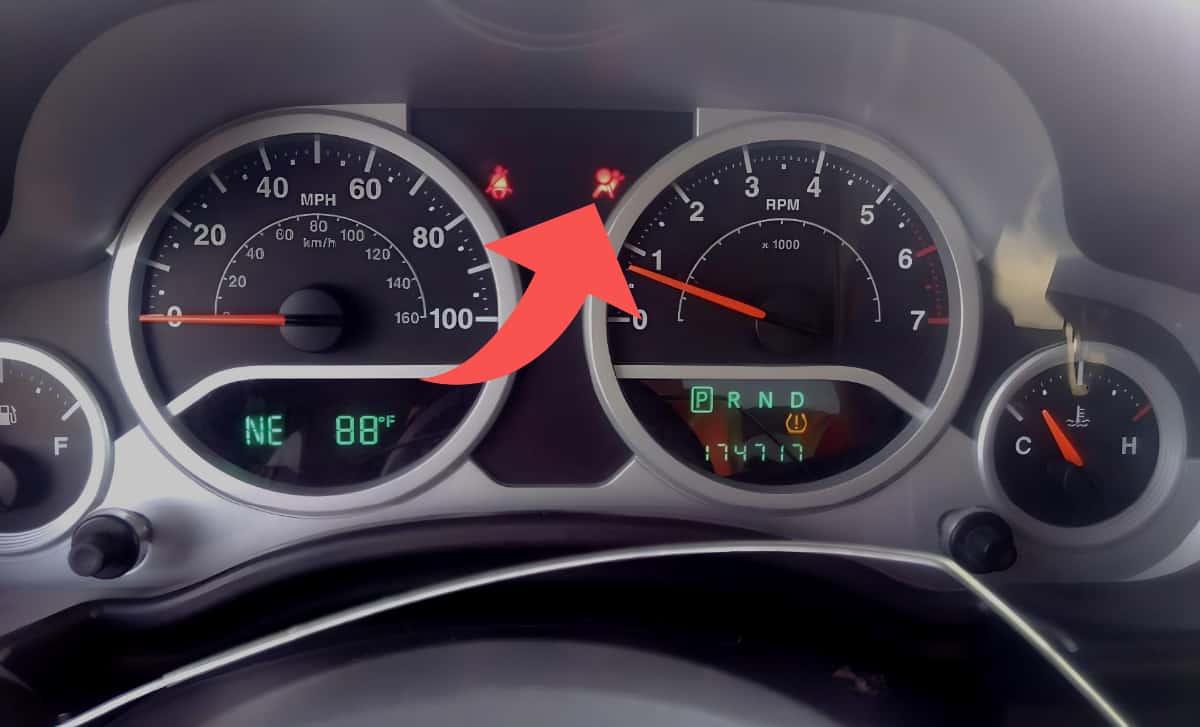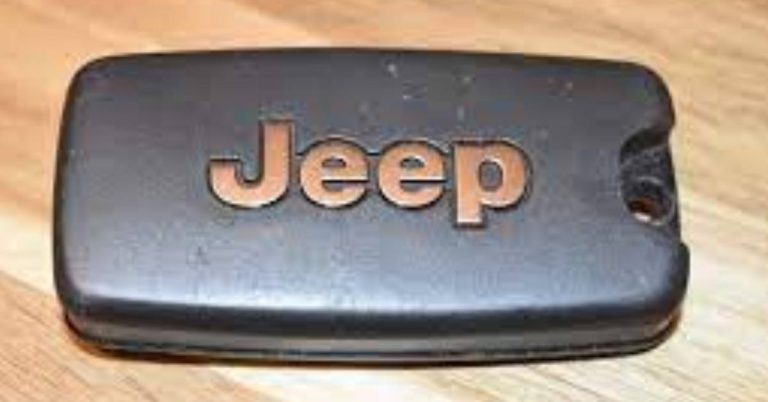What do the lights on my Jeep mean? A handy guide to understanding their meanings

Have you ever been driving your Jeep and suddenly noticed a mysterious light on your dashboard?
You’re not alone.
Jeep dashboard symbols can range from simple reminders to potentially serious issues.
In this article, we’ll delve into the fascinating world of Jeep warning lights and explore how a cheat sheet can be your saving grace when it comes to diagnosing problems.
Buckle up, because things are about to get enlightening!
What do the lights on my Jeep mean
The lights on your Jeep’s dashboard indicate various problems and warnings that you should pay attention to.
Some important symbols to be aware of include the master warning light, which suggests multiple problems, the oil warning light indicating low engine oil pressure, the tire pressure warning light for low tire pressure, and the check engine light for various issues.
Other important lights include the “BRAKE” warning sign for worn-down brakes, the “ABS” light indicating a problem with the anti-lock braking system, and the battery warning light for battery issues.
It is also important to pay attention to lights indicating low fuel, low washer fluid, and engine temperature.
Additionally, symbols related to the electric throttle control, driver attention alert, lane sense, 4WD system, adaptive cruise control, towing system, and stability control system should not be ignored.
Refer to your vehicle’s owner’s manual or consult a Jeep service technician for further assistance in identifying the different symbols on the dashboard.
Key Points:
- Jeep dashboard lights indicate various problems and warnings.
- Important symbols include master warning light, oil warning light, tire pressure warning light, and check engine light.
- Other important lights include BRAKE warning sign, ABS light, and battery warning light.
- Also pay attention to lights indicating low fuel, low washer fluid, and engine temperature.
- Symbols related to electric throttle control, driver attention alert, lane sense, 4WD system, adaptive cruise control, towing system, and stability control system should not be ignored.
- Consult vehicle’s owner’s manual or Jeep service technician for further assistance.
Check this out:
💡 Did You Know?
1. The lights on your Jeep, specifically the yellow or amber fog lights, are designed to help improve your visibility during adverse weather conditions like fog, heavy rain, or snow.
2. If you have noticed a red light flashing intermittently on your Jeep’s dashboard, it indicates that the vehicle’s alarm system is active and operational.
3. The blinking blue light on your Jeep’s dashboard is usually a notification that your vehicle’s high beam headlights are engaged.
4. The green light on your Jeep’s dashboard, typically in the shape of a car with an arrow pointing downward, is the indicator for the vehicle’s cruise control system. It illuminates when the feature is activated.
5. Some Jeep models have a small white light on the dashboard, shaped like a tire with an exclamation mark inside it. This light is the TPMS (Tire Pressure Monitoring System) warning light, indicating that there might be an issue with one or more of your tires’ pressure.
Importance Of Jeep Dashboard Symbols
Jeep dashboard symbols are essential indicators of potential problems in your vehicle. Paying attention to these symbols is crucial because they can range from mild issues to severe complications. Ignoring the warning signs can lead to costly repairs or safety hazards. Therefore, understanding the meanings behind these symbols is essential for every Jeep owner.
To assist Jeep owners in diagnosing problems quickly, a Jeep warning light cheat sheet is available. This cheat sheet serves as a handy guide to all the different symbols and their corresponding meanings. By referring to this cheat sheet, Jeep owners can identify the issue promptly and take appropriate action. It is a valuable resource that every Jeep owner should have to avoid unnecessary hassles or expenses.
- Jeep dashboard symbols are crucial for indicating vehicle problems.
- Ignoring these symbols can lead to costly repairs or safety hazards.
- Understanding the meanings behind the symbols is essential for Jeep owners.
- A Jeep warning light cheat sheet provides a handy guide to the symbols and their meanings.
- Referring to the cheat sheet helps owners quickly identify and address issues.
Understanding The Master Warning Light
One of the most critical symbols on a Jeep dashboard is the master warning light. This symbol is indicated by a triangle with an exclamation point in the center. It suggests that multiple problems have been detected in the vehicle. When this warning light appears, it is essential to address it promptly.
The master warning light can indicate a range of issues, including problems with the engine, transmission, or electrical system. It may also point to low fluid levels or other critical failures. Ignoring this warning light can result in further damage to your Jeep and potentially costly repairs.
Therefore, whenever the master warning light appears, it is crucial to consult the vehicle’s owner’s manual or seek assistance from a Jeep service technician to diagnose and fix the underlying problems.
- The master warning light symbol is a triangle with an exclamation point
- Address the warning light promptly to avoid further damage
- Problems with the engine, transmission, or electrical system can be indicated
- Low fluid levels or other critical failures can also be indicated
- Consult the vehicle’s owner’s manual or seek assistance from a Jeep service technician for diagnosis and repair.
Decoding The Oil Warning Light
Another vital symbol on the Jeep dashboard is the oil warning light. This symbol indicates low engine oil pressure, which can lead to severe engine damage if left unaddressed. When this warning light illuminates, it is crucial to take immediate action.
Low engine oil pressure can result from various issues, including:
- Malfunctioning oil pump
- Leaking oil filter
- Insufficient oil levels
Continuing to drive the vehicle with low oil pressure can cause the engine to overheat and seize, resulting in expensive repairs or even engine replacement.
To address this issue, follow these steps:
1. Check the engine oil level using the dipstick
2. Add oil if necessary
3. If the oil level is adequate, it is essential to consult a Jeep service technician to diagnose and resolve any underlying issues causing the low oil pressure warning.
It is important to remember that neglecting the oil warning light can have serious consequences for your vehicle’s engine. Do not ignore this warning and take appropriate action to avoid costly repairs in the future.
Interpreting The Tire Pressure Warning Light
The tire pressure warning light on the Jeep dashboard is a crucial indicator that should never be ignored. This symbol illuminates when the tire pressure in one or more of the tires is low.
Driving with low tire pressure can affect vehicle control and increase the risk of blowouts, leading to potential accidents.
Low tire pressure can result from gradual air leakage, changes in temperature, or punctures. When the tire pressure warning light appears, it is vital to check the tire pressure using a tire pressure gauge. If any tires have significantly low pressure, they should be inflated to the recommended level.
Regularly monitoring tire pressure and maintaining proper inflation is essential for optimal vehicle performance, extended tire life, and improved safety. If the tire pressure warning light continues to illuminate despite maintaining proper inflation, it is necessary to consult a Jeep service technician to inspect for any underlying issues with the tire pressure monitoring system.
Dealing With The Check Engine Light
The check engine light on a Jeep dashboard is a common and often anxiety-inducing symbol. This light can indicate various issues, ranging from minor problems to more severe engine malfunctions.
One common cause of the check engine light is a loose gas cap. When the gas cap is not properly tightened, fuel can evaporate, resulting in a false warning in the emissions system. If the “Loose Gas Cap Warning” light appears, it is crucial to tighten the gas cap securely.
However, if the check engine light remains illuminated or appears without any gas cap issues, it is recommended to consult a Jeep service technician. They can diagnose the underlying problem using specialized diagnostic tools and determine the necessary repairs or maintenance required to resolve the issue.
- Tighten the gas cap securely if the “Loose Gas Cap Warning” light appears.
- Consult a Jeep service technician if the check engine light remains illuminated or appears without any gas cap issues.
The Brake And ABS Warning Signs
The “BRAKE” warning sign on the Jeep dashboard indicates that the brakes are wearing down or compromised. It is essential to address this warning promptly to ensure safe braking performance.
The “ABS” light indicates a problem with the anti-lock braking system. The anti-lock braking system plays a crucial role in preventing wheel lock-up during emergency braking, ensuring the driver maintains control of the vehicle. When the ABS light illuminates, it is necessary to have the system inspected by a Jeep service technician to identify and resolve any issues.
Maintaining the braking system’s integrity is essential for the overall safety of the vehicle. Therefore, any brake-related warning sign should not be ignored, and the vehicle should be inspected by a professional immediately.
- Address the “BRAKE” warning sign promptly to ensure safe braking performance
- Have the “ABS” light inspected by a Jeep service technician to resolve any issues with the anti-lock braking system
- Don’t ignore any brake-related warning signs
- Have the vehicle inspected by a professional immediately in case of any brake-related warning sign.
Battery And Fuel Warning Lights
Faulty alternators or infrequent driving can cause issues with the battery. When the battery warning light, indicated by positive and negative symbols, appears on the Jeep dashboard, it signifies a problem with the battery or charging system. Seeking professional help to diagnose and fix the issue is crucial to prevent battery failure and unexpected breakdowns.
The “Low Fuel Warning” light is a simple yet important symbol indicating that it’s time to find a gas station and refuel the vehicle. Ignoring this warning light can leave you stranded on the road, so it is essential to refuel promptly.
The “Fuel Shut-Off Alert” symbol is more severe and indicates that something has cut off the vehicle’s fuel supply. This symbol should not be ignored, as it could lead to a complete shutdown of the vehicle. Seeking immediate assistance is crucial to diagnose and address the issue to ensure continued safe operation of the Jeep.
Recognizing Other Jeep Dashboard Symbols
Jeep Dashboard Symbols: Understanding their Meanings and Importance
Jeep dashboard symbols encompass a wide range of indicators, each serving as a potential warning or indicator of system failures in the vehicle. It is essential to understand these symbols to recognize potential problems promptly.
One critical symbol is the Engine Temperature Indicator. It warns if the engine temperature gets too hot, indicating possible issues with the cooling system. Problems like a malfunctioning radiator, low coolant levels, or a faulty thermostat can lead to overheating, which can cause severe engine damage. Therefore, it is crucial to address this warning immediately and seek professional assistance.
Another significant symbol to be aware of is the Low Washer Fluid Indicator. Represented by a fan with water bursting out, it notifies the driver that the washer fluid levels are low. Regularly topping up the washer fluid is a simple task that helps maintain clear visibility while driving.
Additionally, there are numerous other symbols, each with distinct meanings related to potential system malfunctions or warnings. These symbols include the Electric Throttle Control Warning, Driver Attention Alert, Forward Collision Alert, Lane Sense Indicators, 4WD Alert, Adaptive Cruise Control Indicators, and many more.
To accurately interpret these symbols, it is highly recommended to consult the vehicle’s owner’s manual or seek assistance from a Jeep service technician. Promptly taking action based on the symbols can save Jeep owners from expensive repairs, ensure the vehicle’s safety, and optimize its performance.
In conclusion, understanding the meanings behind the various symbols on a Jeep dashboard is vital for every Jeep owner. These symbols indicate potential problems or warnings that require attention to prevent costly repairs or safety hazards. By referring to a Jeep warning light cheat sheet and consulting the owner’s manual or a Jeep service technician, owners can quickly diagnose the issue and take appropriate action, ensuring the longevity and optimal performance of their Jeep.
FAQ
What are the warning lights on a Jeep Wrangler?
The warning lights on a Jeep Wrangler include the Oil Temperature Warning Light, indicating high oil temperature that could lead to engine damage. The Oil Pressure Warning Light alerts the driver of low oil pressure, which can cause engine failure if not addressed. The Electric Power Steering Fault Warning Light signals a problem with the vehicle’s power steering system, potentially affecting steering functionality. The Anti-Lock Brake System Warning Light indicates a malfunction in the vehicle’s ABS system, which can impact braking performance. The Service Forward Collision Warning Light serves as a reminder to have the forward collision warning system checked. The Water in Fuel Indicator Light warns the driver of the presence of water in the fuel system, necessitating inspection and possible maintenance.
What certain lights mean on dashboard?
Dashboard lights are designed to provide important information about the status of your vehicle. For instance, green or blue lights indicate that a system is functioning properly, providing reassurance that all is well. On the other hand, orange or yellow warning lights serve as a gentle reminder that your vehicle might require a service or repair soon, warranting attention but not immediate action. However, the presence of a red light demands immediate attention, signaling that it is time to take action without delay.
What does the A symbol mean in a jeep?
The A symbol in a Jeep represents the Auto-Stop mode. This means that when this symbol is displayed on the dashboard, it indicates that the Stop/Start feature is active. This feature allows the engine to automatically turn off when the vehicle comes to a complete stop, such as at a traffic signal, to conserve fuel. Once the driver releases the brake pedal or pushes down on the accelerator, the engine automatically restarts, indicated by the disappearance of the A symbol.
What is the a light with a circle around it on a jeep?
The light with a circle around it on a Jeep is a Stop/Start Active Light. This light, displaying an “A” inside an open circle, indicates when the vehicle is in Auto-Stop mode. It is one of the many indicator lights present on the Jeep Cherokee, alongside various warning lights.



